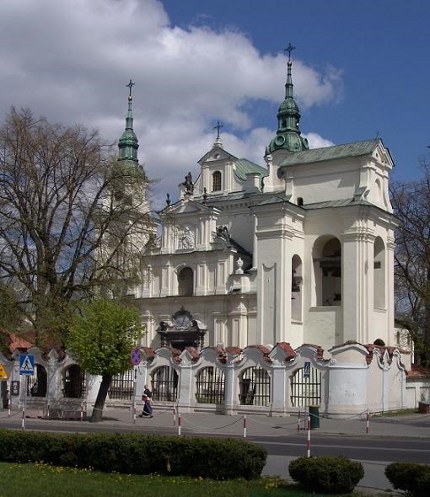k-r


A town founded in 1543 by the Lublin Voivod Piotr Firlej (Firlej’s coat of arms called the Lewart gave the original name to the town – Lewartów). In the past it was a thriving centre of the Reformation, in the 18th c. became the property of the Sanguszko Family. Prince Paweł Karol Sanguszko founded many Baroque buildings in the town e.g. St. Anne’s Parish Church, St. Lawrence’s Church of the Capuchin Order, and a palace in the geometrically arranged park with a pond. Some examples of the historic architecture in the market square have survived to the present day. In Kościuszko Stree ...

Lublin is one of the most attractive cities in Poland, awarded with the Polish Tourist Brand title. Original in over 70% architecture of the Old Town attracts the visitors from all over the world. Lublin Old Town with its well-preserved, mainly Renaissance buildings with traces of Gothic, Baroque, and Classicism, was honoured with the title of Historic Monument along with the Castle Hill and part of the city centre. The city's multicultural, over 700-year history is confirmed by numerous monuments. Among the most valuable ones is the Chapel of the Holy Trinity, with th ...

The Lubycza Królewska Commune, located in the heart of Eastern Roztocze, is a place where nature harmoniously intertwines with the region's history and culture. Its centre is the small, picturesque town of Lubycza Królewska, whose origins date back to the 15th century. Before World War II, around 90% of its population were Jews, which left a lasting mark on the local heritage – while strolling through the town, one can come across the former Jewish school building (Bet Ha-Midrash). Among the town’s most valuable landmarks are the neo-Gothic Holy Trinity Church from 1904, which houses a 1 ...

The town on the Wieprz River, founded in 1476, has been a large trade center since the Jagiellonian times. Merchants from all over Europe came to fairs, and Łęczna became one of the most important towns of the voivodeship. Three markets have preserved until modern times remind of the fair traditions. In the 1960s, hard coal deposits were discovered near Łęczna, which started a new phase in the history of the city. In 1975, the construction of the mine in Bogdanka was commenced, and Łęczna became the capital of the new Lublin Coal Basin. ...

A town in the Southern Podlasie Lowland founded in 1369, a historic capital of the Łuków Land. The most interesting historic sights are the 18th-century Baroque churches and monasteries of the Bernardine Order and of the Piarist Order. ...

Places of interest in Markuszów include: the Lublin Renaissance Church of the Holy Spirit, 17th-century St. Joseph’s Parish Church with a bell tower and an 18th-century presbytery, the Jewish cemetery with matzevahs from before 1942, parish cemetery with a monument to the locally-born folk poet Jan Pocek (1917 ? 1971), and old forest stands. ...

A village in the Hrubieszów Valley where archaeologists have discovered 2nd-century settlements and burial grounds of the Goths. The excavated finds are displayed in museums in Hrubieszów and Zamość, whereas in Masłomęcz a traditional Gothic hut has been reconstructed and serves as a venue for events popularising Gothic customs and the intriguing history of the place. ...

Jedno z najbardziej malowniczych miejsc w województwie lubelskim skrywa dolina Wisły w pobliżu Kazimierza Dolnego. Mięćmierz to dawna osada rybacka, a współcześnie miejscowość wypoczynkowa, która pozwala przenieść się do odległych czasów. Kryte strzechą chałupy, drewniane płoty i cisza panująca w tym urokliwym zakątku, w połączeniu z powolnym nurtem Wisły sprawiają, że odwiedzający doświadczają prawdziwego ukojenia. Centralny placyk osady zajmuje studnia z daszkiem krytym gontem. Nieco dalej na skarpie wiślanej znajduje się wiatrak kożlak, przetransportowany z � ...

A town situated by the historic route leading from Brest to Małopolska, in the past famed for salt-works and breweries, and later for the bristle trade and industry developed by local Jews. Historic commercial architecture with narrow streets and arched buttresses has been preserved. The oldest historic building is St. Nicholas’ Church, originally built as a Gothic temple and reconstructed after the fire in 1752 in the Baroque style. At the main altar hang paintings from the Szymon Czechowicz school of painting, probably the work of Łukasz Smuglewicz. ...

A village on the border of Western Roztocze and the Sandomierska Valley (a town from the 17th c. to the 19th c.) with historic wooden small town architecture from the turn of the 20th c., a late-Baroque synagogue from 1760, and the Parish Church of St. Stanislaus Bishop and Martyr, built in the years of 1664–68 and decorated with stucco ornaments characteristic of the Lublin Renaissance. ...
Page 3 of 5











